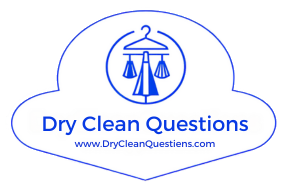Dry cleaning isn’t vital for every garment in your closet, but it’s absolutely critical for delicate fabrics like silk, wool, and cashmere that water would damage. You’ll also need professional care for structured pieces, leather, and embellished items with sequins or embroidery. While cotton, polyester, and many modern synthetics handle home washing just fine, investing in dry cleaning for high-value pieces protects your wardrobe investment and prevents costly replacements that’ll make your wallet weep. Understanding which fabrics truly require professional attention helps you make smarter cleaning choices.
Understanding What Dry Cleaning Actually Does
While most of us toss our clothes into the washing machine without a second thought, dry cleaning operates on an entirely different principle that’s honestly pretty fascinating once you understand it.
Instead of water, professional cleaning services use specialized chemical solvents that dissolve stains and dirt without the harsh agitation that can damage delicate fabrics like silk, wool, or cashmere.
You’ll notice those care instructions on your favorite blazer exist for good reason – dry cleaning helps maintain the integrity of intricate weaves, preserves vibrant colors, and prevents that dreaded shrinkage we’ve all experienced 😅.
The multi-step process includes inspection, targeted stain removal, gentle solvent cleaning, and careful pressing, guaranteeing your garments keep their original shape and texture for years to come.
The most common solvent used is perchloroethylene, though many cleaners are now switching to more environmentally friendly hydrocarbon or silicone-based alternatives.
Fabrics That Truly Require Professional Solvent Cleaning
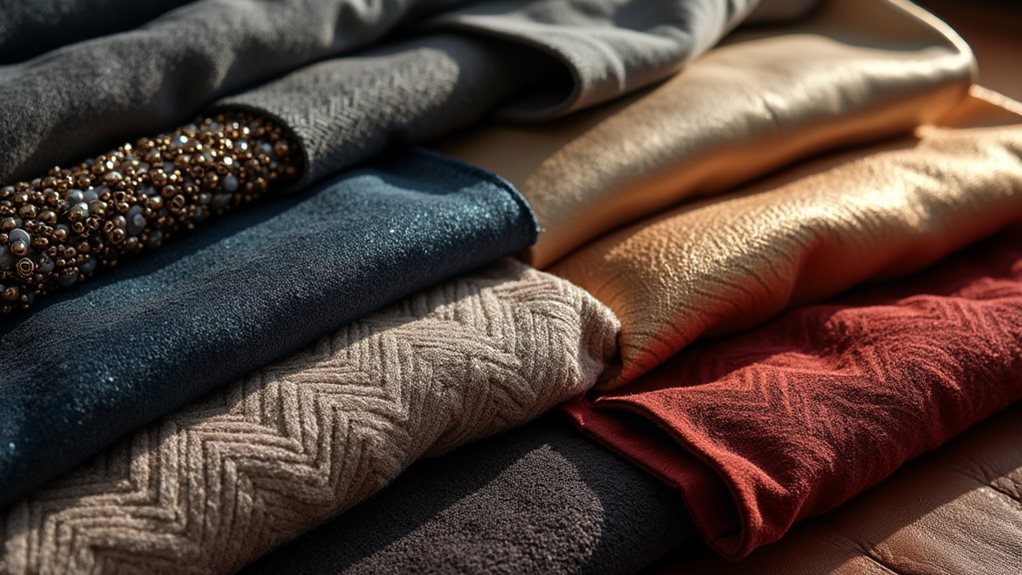
Certain fabrics basically throw a tantrum when they meet water, and learning to recognize these divas in your closet can save you from some truly heartbreaking wardrobe disasters.
Your silk blouses, wool sweaters, and cashmere scarves literally need professional dry cleaning because water destroys their delicate fibers, turning your $200 investment into expensive rags 😅.
Don’t let water turn your expensive silk and cashmere into costly mistakes—some fabrics demand professional care.
Velvet garments and leather pieces also demand this specialized care to prevent color bleeding and structural damage.
When you’re dealing with embellished pieces featuring sequins or embroidery, those stubborn stains from spilled wine, or tricky fabrics like acetate and rayon, always check the care label first.
These delicate fabrics aren’t being high-maintenance for fun—they genuinely require professional dry cleaning’s gentle solvents to maintain their beauty.
The chemical solvents used in professional dry cleaning are particularly effective at removing oil-based stains that water simply cannot eliminate from these sensitive materials.
When Home Washing Can Replace Dry Cleaning Services
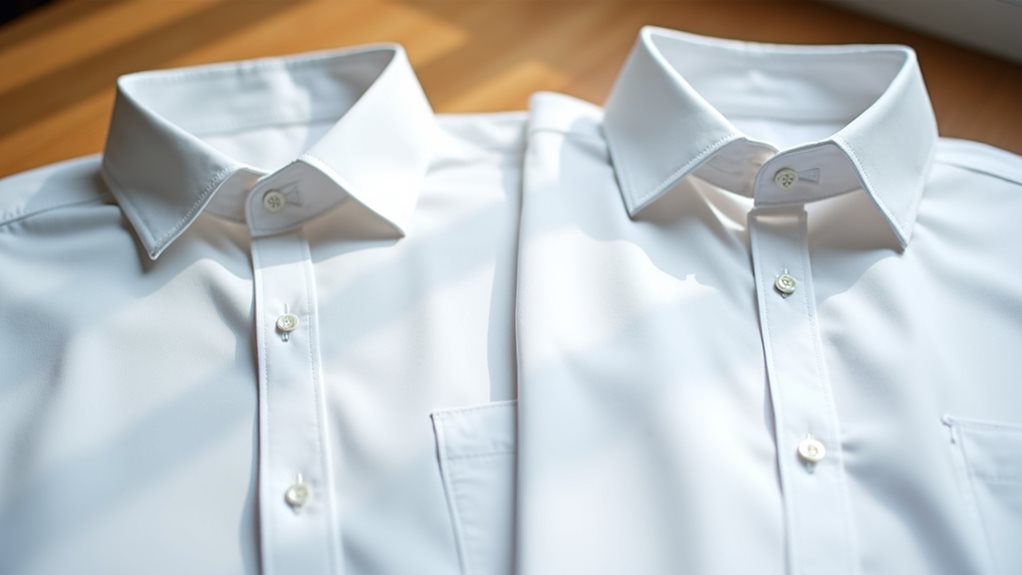
You’ll be surprised to discover that many items hanging in your closet, especially those made from synthetic fabrics like polyester and nylon, can skip the dry cleaner entirely and go straight into your trusty washing machine at home.
I’ve learned the hard way that understanding which fabrics respond well to home washing, mastering gentle techniques like cold water cycles and proper detergent selection, can save you hundreds of dollars annually while keeping your clothes just as fresh and clean.
Before attempting to wash any “dry clean only” garment at home, always perform a colorfastness test to check if the fabric’s dyes will bleed or run during the washing process.
The key lies in recognizing when your garments don’t actually need those expensive chemical solvents, because honestly, most of us have been overthinking this whole dry cleaning thing for years!
Machine-Washable Fabric Types
Your laundry basket holds more machine-washable treasures than you might realize, and I learned this the hard way after spending a small fortune at the dry cleaner before discovering that many of my “dry clean only” assumptions were completely wrong.
Synthetic fabrics like polyester and nylon thrive in regular washing cycles, while cotton and linen items practically beg for home laundering.
Even delicate garments surprised me—my modern wool sweaters handle gentle machine cycles beautifully, and some silk pieces survive careful hand-washing when I test for colorfastness first.
The secret weapon? Those tiny care labels sewn into seams that I used to ignore completely.
They’re like treasure maps showing exactly which machine-washable options you have, potentially saving hundreds annually 💰.
Proper Home Techniques
When I first started experimenting with home techniques as alternatives to dry cleaning, I felt like a detective uncovering hidden secrets that could save me serious money while keeping my favorite garments looking pristine.
You’ll discover that proper care doesn’t require professional services when you master these gentle methods.
For delicate fabrics like silk, use tepid water with mild detergent, swishing carefully rather than aggressively scrubbing. Your washing machine’s gentle cycle works wonders for wool items in cold water, while cashmere needs hand-washing every 7-10 wears to extend lifespan.
Cotton dress shirts? Skip the dry cleaning entirely – cold water washing and air-drying prevents shrinkage beautifully.
At-home dry cleaning kits with special cloths and stain removers provide another effective option for maintaining garments that typically require professional cleaning.
These techniques have saved me hundreds while maintaining my wardrobe’s quality!
Cost-Effective Washing Alternatives
Building on those foundational skills, I’ve discovered that strategic home washing can replace expensive dry cleaning services for a surprising number of garments, and honestly, my wallet couldn’t be happier about this revelation.
Your cotton dress shirts, linen pants, and most synthetic blends respond beautifully to cold water washing, which can extend the lifespan considerably while keeping costs down 📊.
I’ve found that delicate fabrics like wool sweaters actually thrive with gentle hand-washing using mild, gentle detergent rather than harsh chemical solvents.
The real game-changer? Mastering immediate spot cleaning techniques for minor stains prevents those panicked trips to the dry cleaner.
Before attempting any home cleaning method, always check garment care labels first to determine whether your specific item can safely be cleaned at home or requires professional dry cleaning services.
This cost-effective home washing approach has saved me hundreds annually while keeping my clothes looking fresh and professional.
Key Factors That Determine Your Cleaning Method Choice
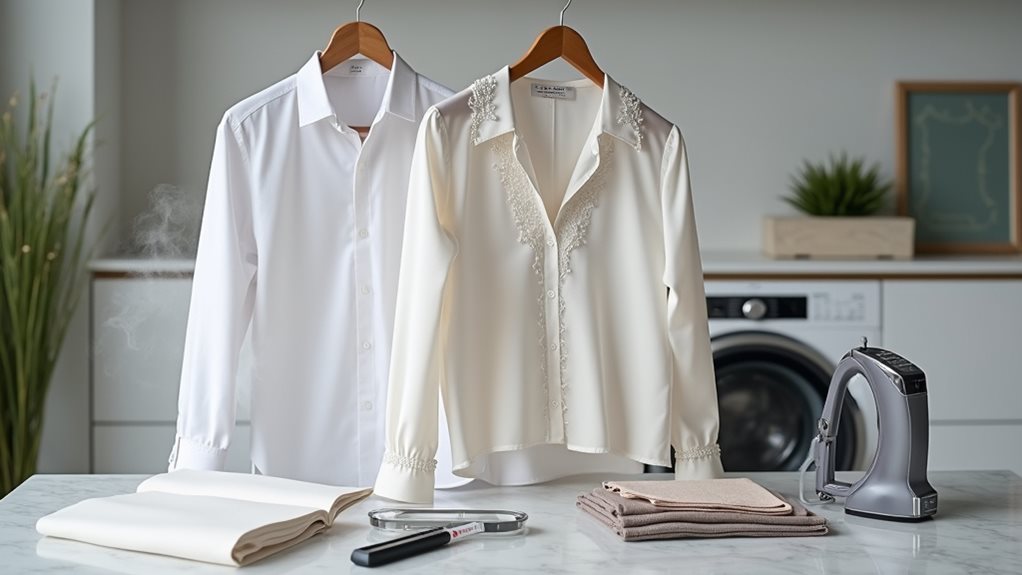
Although the care label might seem like the obvious starting point, I’ve learned through countless laundry mishaps that choosing the right cleaning method actually depends on several interconnected factors that work together like pieces of a puzzle.
Your fabric type comes first—delicate garments like silk blouses and cashmere sweaters practically beg for dry cleaning, while my favorite cotton tees can handle whatever washing machine torture I throw at them.
Delicate fabrics like silk and cashmere demand gentle dry cleaning, while sturdy cotton can survive any washing machine adventure.
Then there’s colorfastness, which I discovered the hard way when my burgundy dress bled all over my white shirts 😅.
Structured garments, especially those customized pieces with sharp pleats, need professional care to maintain their shape, while your care label provides the final confirmation of what your garment truly needs.
Items with intricate beading or embellishments also require the gentle treatment that chemical solvents provide, as water-based washing can damage these decorative elements or cause them to fall off entirely.
Cost-Benefit Analysis of Professional vs. Home Care
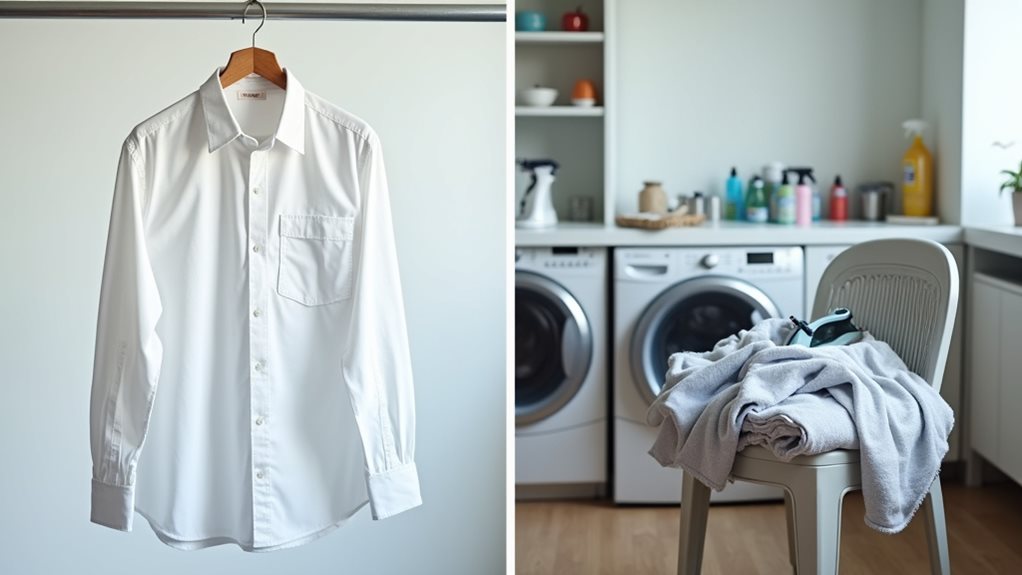
Two years ago, I nearly cried when I calculated how much I’d spent on dry cleaning my work wardrobe in a single month—$127 for just four blazers and three dresses—but that sticker shock taught me the most valuable lesson about garment care economics.
Here’s what professional dry cleaning actually saves you:
- Fabric longevity – Your delicate fabrics like silk and wool stay pristine for years instead of shrinking or losing shape after home washing disasters.
- Stain rescue missions – Professional solvents tackle stubborn stains that’d otherwise ruin expensive pieces permanently.
- Replacement prevention – Maintaining structure in customized garments means you’re not buying new blazers every season.
While home care seems cheaper upfront, professional cleaning can extend the life of quality pieces, making that monthly investment worthwhile for your wardrobe’s long-term health. The chemical solvents used in dry cleaning are specifically designed to remove oil-based stains without the fabric damage that water-based washing can cause to delicate materials.
Making Smart Decisions for Your Wardrobe’s Longevity

When you’re standing in your closet holding that gorgeous cashmere sweater you splurged on last winter, you need to honestly assess whether the fabric demands professional care or if your gentle home washing skills can handle the job.
I learned this lesson the hard way when I tossed a $200 wool blazer into my washing machine thinking I could save a few bucks – let’s just say it now fits my neighbor’s toddler perfectly 😅.
The key is weighing the garment’s actual value against the cost of professional cleaning, because sometimes that $15 dry cleaning bill is protecting a much bigger investment in your wardrobe’s future.
Unlike traditional washing methods that use water and can cause shrinkage or color bleeding, dry cleaning uses chemical solvents to safely clean delicate fabrics while preserving their original structure and appearance.
Fabric Care Assessment
Five key factors determine whether your favorite garments truly need professional dry cleaning, and understanding these elements can save you both money and heartache when caring for your wardrobe.
Think of fabric care as detective work – you’re gathering clues to solve the mystery of proper maintenance. Start by examining your garment’s material composition, since delicate fabrics like silk whisper “handle with care” while cotton shouts “throw me in the washer!” 😊
Here’s your assessment checklist:
- Check the care label first – it’s literally the manufacturer’s roadmap for keeping your clothes happy.
- Test colorfastness by dabbing a hidden area with water to see if dyes bleed.
- Evaluate structural elements like pleats, padding, or intricate beadwork that water might damage.
When doubt creeps in, professional dry cleaning beats expensive replacement costs every single time. Dry cleaning also excels at removing oil-based stains that regular washing machines simply cannot tackle effectively.
Cost vs. Garment Value
Smart shoppers understand that dry cleaning costs should align with their garment’s actual worth, because spending $25 to clean a $30 blouse makes about as much financial sense as buying premium gas for a broken-down car.
When evaluating garment value, consider whether professional care will extend their lifespan enough to justify the expense. High-end garments like silk blazers or cashmere coats absolutely deserve regularly dry cleaning, since a $15 investment protects hundreds of dollars in clothing value.
However, that polyester dress from a fast-fashion retailer? You’re better off hand-washing it at home.
The sweet spot lies in protecting pieces you genuinely love and can’t easily replace, while being selective about items that won’t benefit greatly from professional treatment. Remember that dry cleaning’s chemical solvents are specifically designed to handle delicate fabrics and structured garments that would be damaged by water-based washing methods.
Professional vs. Home Methods
Nobody wants to admit they’ve ruined their favorite sweater in the washing machine, but we’ve all been there – standing in our laundry room, holding what used to be a perfectly fitted cashmere pullover that now looks like it belongs on a toddler.
Here’s when professional dry cleaning becomes your wardrobe’s best friend versus risky home methods:
- Delicate fabrics like silk, wool, and cashmere need specialized solvents that won’t strip their natural oils or cause shrinkage.
- Structured garments maintain their custom shape through professional pressing techniques you can’t replicate at home.
- Tough stains require industrial-grade treatment that your laundry room simply can’t match.
While home methods work perfectly for everyday cotton tees, investing in professional care helps your quality garments maintain their integrity, appearance, and longevity – saving you money long-term.
